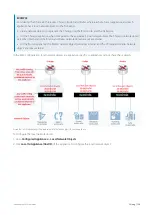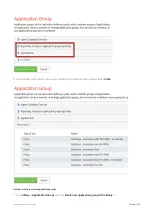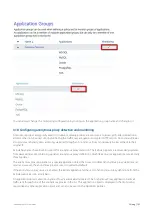
Exinda Network Orchestrator
3 Using
|
142
Active Directory Dynamic Network Objects - When Active Directory users or groups are defined, a corresponding
dynamic network object is automatically created. This dynamic network object is populated by the hosts that make up
that particular Active Directory user or group. For further information, see the
Integrate with Active Directory
and
.
Screenshot 41: Select the desired dynamic network object to show the IP addresses/User
Screenshot 42: Select a configured adaptive response network object or a user network object or user group network object
To view it, go to
Configuration > Objects > Users & Groups
.
3.1.3 Working with users and groups as objects
Users and groups objects are used to define pre-populated users and groups such that they can be used for monitoring
and optimization.
There are two ways the Exinda Appliance can learn about user and group information:
1.
: The Exinda Appliance can receive user and group information using the Exinda Active Directory Ser-
vice, installed on Active Directory Servers.
2.
Static Users and Groups: Static users and group information can be only entered using the CLI "networkuser" com-
mand.
Содержание EXNV-10063
Страница 98: ...Exinda Network Orchestrator 2 Getting started 98 6 Click New The New Virtual Hard Disk wizard opens ...
Страница 99: ...Exinda Network Orchestrator 2 Getting started 99 7 Select VHDX as the Disk Format type and click Next ...
Страница 130: ...Exinda Network Orchestrator 2 Getting started 130 Screenshot 35 The life cycle of configuration status ...
Страница 369: ...Exinda Network Orchestrator 4 Settings 369 ...
Страница 411: ...Exinda Network Orchestrator 4 Settings 411 Screenshot 168 P2P OverflowVirtualCircuit ...
Страница 420: ...Exinda Network Orchestrator 4 Settings 420 Screenshot 175 Students OverflowVirtualCircuit ...
Страница 451: ...Exinda Network Orchestrator 4 Settings 451 ...















































